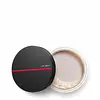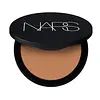Shiseido Synchro Skin Invisible Silk Loose Powder Versus NARS Cosmetics Soft Matte Advanced Perfecting Powder
What's inside
What's inside
 Key Ingredients
Key Ingredients

 Benefits
Benefits

 Concerns
Concerns

 Ingredients Side-by-side
Ingredients Side-by-side

Synthetic Fluorphlogopite
Silica
AbrasiveVinyl Dimethicone/Methicone Silsesquioxane Crosspolymer
Mica
Cosmetic ColorantMethyl Methacrylate Crosspolymer
Dimethicone
EmollientHydrogen Dimethicone
Distearyldimonium Chloride
Phenoxyethanol
PreservativeCI 77491
Cosmetic ColorantChlorphenesin
AntimicrobialCI 77492
Cosmetic ColorantIsopropyl Alcohol
SolventWater
Skin ConditioningCI 77891
Cosmetic ColorantCellulose
AbsorbentNacre Powder
AbrasiveMethyl Methacrylate/Acrylonitrile Copolymer
Polysilicone-2
Butylene Glycol
HumectantPolymethylsilsesquioxane
Dimethicone/Vinyl Dimethicone Crosspolymer
Skin ConditioningPolyquaternium-51
Skin ConditioningStearic Acid
CleansingIsobutane
Aluminum Hydroxide
EmollientIsopentane
SolventThymus Serpyllum Extract
Skin ConditioningSynthetic Fluorphlogopite, Silica, Vinyl Dimethicone/Methicone Silsesquioxane Crosspolymer, Mica, Methyl Methacrylate Crosspolymer, Dimethicone, Hydrogen Dimethicone, Distearyldimonium Chloride, Phenoxyethanol, CI 77491, Chlorphenesin, CI 77492, Isopropyl Alcohol, Water, CI 77891, Cellulose, Nacre Powder, Methyl Methacrylate/Acrylonitrile Copolymer, Polysilicone-2, Butylene Glycol, Polymethylsilsesquioxane, Dimethicone/Vinyl Dimethicone Crosspolymer, Polyquaternium-51, Stearic Acid, Isobutane, Aluminum Hydroxide, Isopentane, Thymus Serpyllum Extract
Synthetic Fluorphlogopite
Calcium Sodium Borosilicate
Mica
Cosmetic ColorantZinc Oxide
Cosmetic ColorantSilica
AbrasiveCaprylic/Capric Triglyceride
MaskingZinc Myristate
Dimethicone
EmollientDiphenylsiloxy Phenyl Trimethicone
Skin ConditioningAlteromonas Ferment Extract
Skin ConditioningTheobroma Cacao Seed Butter
EmollientTocopheryl Acetate
AntioxidantQuercetin
AntioxidantHydrogen Dimethicone
Polysilicone-2
Aluminum Hydroxide
EmollientBoron Nitride
AbsorbentSorbitan Sesquiisostearate
EmulsifyingCalcium Silicate
AbsorbentEthylhexylglycerin
Skin ConditioningTocopherol
AntioxidantWater
Skin ConditioningButylene Glycol
HumectantButyrospermum Parkii Butter
Skin ConditioningGlycerin
HumectantHydrolyzed Pea Protein
EmollientGlucose
HumectantSodium Chloride
MaskingSodium Succinate
BufferingNiacinamide
SmoothingLauroyl Lysine
Skin ConditioningChlorphenesin
AntimicrobialPhenoxyethanol
PreservativeIron Oxides
CI 77891
Cosmetic ColorantSynthetic Fluorphlogopite, Calcium Sodium Borosilicate, Mica, Zinc Oxide, Silica, Caprylic/Capric Triglyceride, Zinc Myristate, Dimethicone, Diphenylsiloxy Phenyl Trimethicone, Alteromonas Ferment Extract, Theobroma Cacao Seed Butter, Tocopheryl Acetate, Quercetin, Hydrogen Dimethicone, Polysilicone-2, Aluminum Hydroxide, Boron Nitride, Sorbitan Sesquiisostearate, Calcium Silicate, Ethylhexylglycerin, Tocopherol, Water, Butylene Glycol, Butyrospermum Parkii Butter, Glycerin, Hydrolyzed Pea Protein, Glucose, Sodium Chloride, Sodium Succinate, Niacinamide, Lauroyl Lysine, Chlorphenesin, Phenoxyethanol, Iron Oxides, CI 77891
Ingredients Explained
These ingredients are found in both products.
Ingredients higher up in an ingredient list are typically present in a larger amount.
Aluminum Hydroxide is a form of aluminum. It can be naturally found in nature as the mineral gibbsite. In cosmetics, Aluminum Hydroxide is used as a colorant, pH adjuster, and absorbent.
As a colorant, Aluminum Hydroxide may add opacity, or reduce the transparency. Aluminum hydroxide is contains both basic and acidic properties.
According to manufacturers, this ingredient is an emollient and humectant. This means it helps hydrate the skin.
In medicine, this ingredient is used to help relieve heartburn and help heal ulcers.
There is currently no credible scientific evidence linking aluminum hydroxide in cosmetics to increased cancer risk.
Major health organizations allow the use of aluminum hydroxide in personal care products and have not flagged it as a carcinogenic risk at typical usage levels.
Learn more about Aluminum HydroxideButylene Glycol (or BG) is used within cosmetic products for a few different reasons:
Overall, Butylene Glycol is a safe and well-rounded ingredient that works well with other ingredients.
Though this ingredient works well with most skin types, some people with sensitive skin may experience a reaction such as allergic rashes, closed comedones, or itchiness.
Learn more about Butylene GlycolChlorphenesin is a synthetic preservative. It helps protect a product against bacteria in order to extend shelf life. In most cases, Chlorphenesin is paired with other preservatives such as phenoxyethanol and caprylyl glycol.
Chlorphenesin is a biocide. This means it is able to help fight the microorganisms on our skin. It is also able to fight odor-releasing bacteria.
Chlorphenesin is soluble in both water and glycerin.
Studies show Chlorphenesin is easily absorbed by our skin. You should speak with a skincare professional if you have concerns about using Chlorphenesin.
Learn more about ChlorphenesinCi 77891 is a white pigment from Titanium dioxide. It is naturally found in minerals such as rutile and ilmenite.
It's main function is to add a white color to cosmetics. It can also be mixed with other colors to create different shades.
Ci 77891 is commonly found in sunscreens due to its ability to block UV rays.
Learn more about CI 77891Dimethicone is a type of synthetic silicone created from natural materials such as quartz.
What it does:
Dimethicone comes in different viscosities:
Depending on the viscosity, dimethicone has different properties.
Ingredients lists don't always show which type is used, so we recommend reaching out to the brand if you have questions about the viscosity.
This ingredient is unlikely to cause irritation because it does not get absorbed into skin. However, people with silicone allergies should be careful about using this ingredient.
Note: Dimethicone may contribute to pilling. This is because it is not oil or water soluble, so pilling may occur when layered with products. When mixed with heavy oils in a formula, the outcome is also quite greasy.
Learn more about DimethiconeHydrogen Dimethicone is a type of silicone.
Mica is a naturally occurring mineral used to add shimmer and color in cosmetics. It can also help improve the texture of a product or give it an opaque, white/silver color.
Serecite is the name for very fine but ragged grains of mica.
This ingredient is often coated with metal oxides like titanium dioxide. Trace amounts of heavy metals may be found in mica, but these metals are not harmful in our personal products.
Mica has been used since prehistoric times throughout the world. Ancient Egyptian, Indian, Greek, Roman, Aztec, and Chinese civilizations have used mica.
Learn more about MicaPhenoxyethanol is a preservative that has germicide, antimicrobial, and aromatic properties. Studies show that phenoxyethanol can prevent microbial growth. By itself, it has a scent that is similar to that of a rose.
It's often used in formulations along with Caprylyl Glycol to preserve the shelf life of products.
Polysilicone-2 is a type of silicone.
Silica, also known as silicon dioxide, is a naturally occurring mineral. It is used as a fine, spherical, and porous powder in cosmetics.
Though it has exfoliant properties, the function of silica varies depending on the product.
The unique structure of silica enhances the spreadability and adds smoothness, making it a great texture enhancer.
It is also used as an active carrier, emulsifier, and mattifier due to its ability to absorb excess oil.
In some products, tiny microneedles called spicules are made from silica or hydrolyzed sponge. When you rub them in, they lightly polish away dead skin layers and enhance the penetration of active ingredients.
Learn more about SilicaSynthetic Fluorphlogopite is the synthethic version of mica. It consists of fluorine, aluminum and silicate.
Synthetic Fluorphlogopite is used to add volume to products.
It is considered non-irritating on the skin.
Learn more about Synthetic FluorphlogopiteWater. It's the most common cosmetic ingredient of all. You'll usually see it at the top of ingredient lists, meaning that it makes up the largest part of the product.
So why is it so popular? Water most often acts as a solvent - this means that it helps dissolve other ingredients into the formulation.
You'll also recognize water as that liquid we all need to stay alive. If you see this, drink a glass of water. Stay hydrated!
Learn more about Water